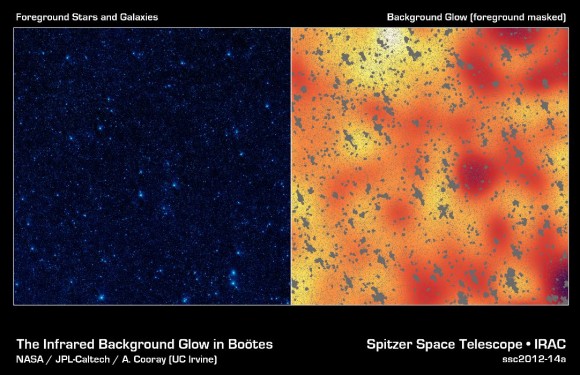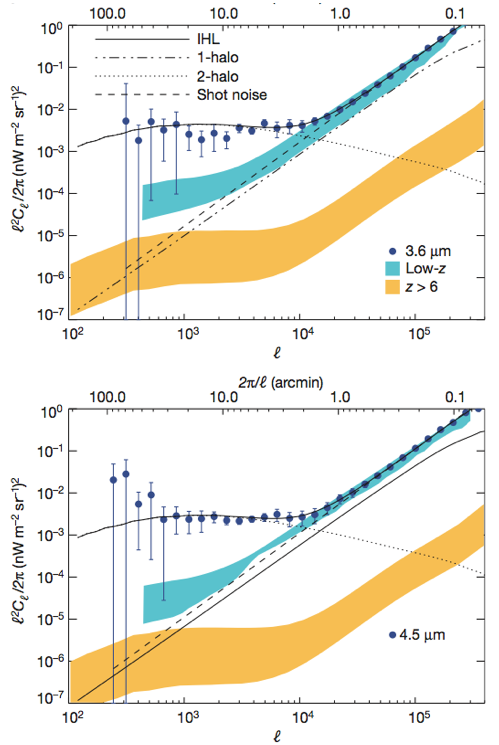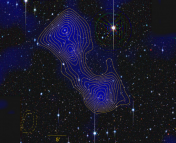TITLE: Near-infrared background anisotropies from diffuse intrahalo light of galaxies
AUTHORS: A. Cooray, J. Smidt, F. De Bernardis, Y. Gong, D. Stern, M. Ashby, P. Eisenhardt, C. Frazer, A. Gonzalez, C. Kochanek, S. Kozlowski, E. Wright
FIRST AUTHOR’S INSTITUTION: University of California, Irvine
A mysterious background of infrared light pervades the Universe at near-infrared wavelengths, and astronomers aren’t sure what causes it, or why it fluctuates from place to place. New observations, however, now cover a large enough fraction of the infrared sky to definitively test the current best explanations for the origin of this widespread glow. Surprisingly, the authors of this work find that neither of the two most popular theories can explain the new observations, but that a relatively recent idea to the field of astronomy can account for their results. They propose that the light is not coming from stars in galaxies, but rather from rogue stars that have been expelled from their host galaxies and now sit in the extended dark matter halos that are known to surround galaxies.
The authors use the Spitzer Space Telescope to make a 10.5 square-degree map of the sky, and they focus on two specific infrared wavelengths, 3.6 and 4.5 microns. The data was collected over 2004 to 2008 as part of the Deep Wide-Field Survey. The authors detect in this map hundreds of individual stars and galaxies, but they also detect the more interesting background light (see the figure below). This infrared glow is what astronomers commonly refer to as the cosmic infrared background. In order to produce this type of diffuse background light, its sources must be too faint or too far away to be imaged individually. Thus, astronomers simply observe the combined infrared light from several objects at once, which leads to the background signal on the sky.

A map of a portion of the sky at infrared wavelengths made by the Spitzer Space Telescope, showing the foreground stars and galaxies (left) and the background glow with the foreground sources masked out (right). (Credit: NASA/JPL-Caltech)
There have been two proposed sources for the background light that have been especially popular to date. One recent explanation suggests that the glow originates from the very first stars and galaxies. The light from these objects has taken over ten billion years to reach us, and thus, they are too distant to be resolved individually. Alternatively, another theory suggests that the background light is from dwarf galaxies that are much closer to us but that are too faint to be detected individually. Observations to date have not covered a large enough portion of the sky to be able to distinguish between these two models.
These past explanations, however, can not account for the new data taken by Cooray et al. The authors compare their results to new theoretical predictions by measuring a statistic known as the power spectrum. It turns out that the background infrared glow is not uniform on the sky, but that some spots are brighter than others. This can be clearly seen in the figure above, which shows the background infrared light with individual stars/galaxies masked out. The power spectrum provides a method to quantify exactly how large these fluctuations in brightness are. It tells us the amplitude of the brightness fluctuations as a function of multipole ℓ. The multipole number is similar to the frequency of a wave, in that a larger multipole number corresponds to fluctuations of a smaller physical scale (roughly the relation ℓ = 180° / θ holds, where θ is the angle on the sky).

The measured power spectrum of the infrared background fluctuations (black points) at 3.6 microns (top) and 4.5 microns (bottom). The spectrum is plotted versus multipole number (bottom x axis) or scale on the sky (top x axis). The expected power spectrum from the first stars/galaxies (yellow) and from faint dwarf galaxies (blue) are also shown. The model for IHL (black curve) can reproduce the observed data points. (Figure 1 of Cooray et al.)
The power spectrum of the fluctuations measured by the authors is shown to the right. The expected results from the first stars/galaxies (labeled as ‘z > 6’) and from dwarf galaxies (labeled as ‘low-z’) are also shown. It is clear that these models do not produce fluctuations that are as large as those observed. However, the authors are able to reproduce their observations by modeling a faint light component coming not from galaxies but from the dark matter halo that surrounds them, denoted as intrahalo light (IHL). The expected power spectrum from this IHL model is shown as the solid curve in the figure, and it agrees well with the observed results.
Is there a physical mechanism that could produce light coming from the dark matter halo around galaxies? After all, the dark matter halo should be dark, right? Well, galaxies are known to undergo numerous interactions and merger events with other galaxies during their lifetime. As two galaxies interact, gravitational forces can fling stars out into the dark matter halo, a process known as tidal stripping. If roughly just one out of every thousand stars in a galaxy is expelled into the dark matter halo, then this diffuse emission from the halos can explain the observed background glow. This miniscule fraction of expelled stars is consistent with theoretical expectations, giving credence to the veracity of this proposed model.
While the authors’ new explanation for the infrared glow seems plausible, large uncertainties do still exist and more investigation is surely needed. If the background light is due to rogue stars in dark matter halos, the observed infrared fluctuations should be correlated with background fluctuations at other wavelengths, namely in the optical and sub-millimeter ranges. Observations at these wavelengths could provide a method of testing our understanding of the IHL in dark matter halos. Furthermore, the future James-Webb Telescope should have the necessary spatial resolution in the infrared to see the true sources of this mysterious background glow, settling the debate once and for all.




